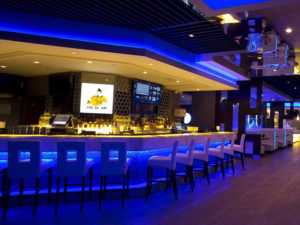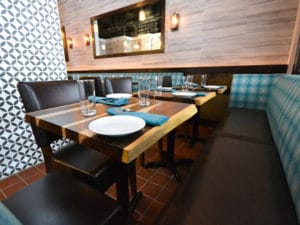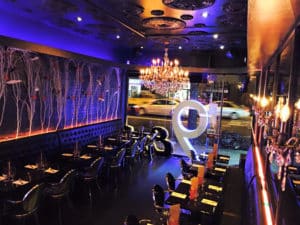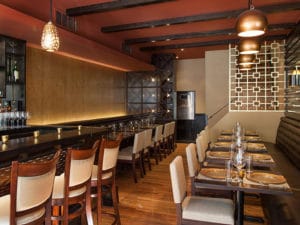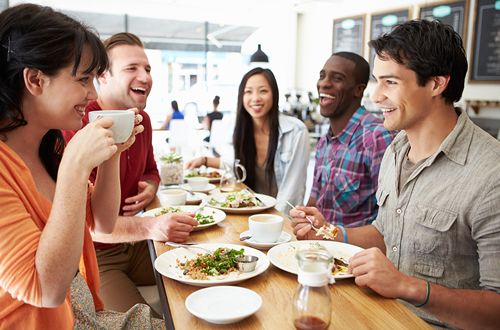Whether you’re designing a restaurant or just refurnishing one, the theme and type of restaurant should be coherent and consistent to attract your preferred clientele. The etymology of “Restaurant” has changed from meaning “a sit down eatery where you are served” to “any place where food is provided”. Wherever you fit on that spectrum, the term restaurant can mean anything from the most prestigious restaurant to your favorite take-out spot. The term “Restaurant” encapsulates almost every meal outside of your residence and it’s hard to distinguish what makes the style of one differ from the next. This article is to better discern one restaurant type from another and determine which profile of restaurant yours fits in best.
Fast-Service Restaurants:

The most universal and affordable is the
Fast-Service Restaurant. These are the well-known fast-service chains which prioritize speed and familiar food and drink. There is no wait service, although some chains deliver the food to your vehicle. Most fast service eateries emphasize bright colors in their décor (although many chains are using more neutral tones to appear more “fast-casual” in atmosphere). The best way to determine if your restaurant is fast-service is your price range for a full meal (~$5-10/person), type of food you serve (familiar meals, ex. burgers, tacos, pizza, etc.), and the type of orders you receive(take out or no service). The fast service restaurant lives off being familiar to their customers, abundancy, cost and quick service.
Examples: McDonald’s, Wendy’s, Taco Bell, Subway and Pizza Hut
Fast-Casual Restaurants:
 Fast-Casual
Fast-Casual Restaurants are becoming one of the fastest growing trends in the restaurant industry. The crucial differences between fast-casual and fast-service are its diverse take on fast-service food and its emphasis on higher quality ingredients. Fast-casual restaurants are more moderately priced (~$8-16/person), but more affordable than casual dining. These restaurants tend to have limited to no table service and the atmosphere varies from place to place. Very recently some fast-casual restaurants have become national successes such as Chipotle and Panera Bread. The way to determine if your restaurant is fast-casual is your price range for a full meal (~$8-16/person), and your restaurants emphasis on quality of the meal (familiar meals with a twist, ex. non-GMO burgers, Mission-style Burritos, artisanal pizzas, etc.). Targeting mostly towards a younger clientele, it doesn’t look like this trend is ending any time soon.
Examples: Shake Shack, Five Guys, Panera Bread and Chipotle.
Casual-Dining Restaurants:
 Casual-Dining
Casual-Dining encapsulates a plethora of genres of eateries, but in general, most serve alcohol (more beer, less wine) and/or are aimed towards families. From High End Brasseries to the local café or pub, they all can be defined as casual dining. It’s also the most affordable full-service style restaurant and a great middle ground between fast-service/fast-casual and fine dining. Some casual dining types don’t offer service such as cafes or buffets, but most do. They are also associated with chains such as an Applebee’s or a Ruby Tuesdays. To determine if your restaurant is casual dining, you can see if it either offers full-service dining, serves alcohol with meals or is categorically casual dining like a buffet or café. Whether you want dinner with the full family or a place for drinks with friends, casual dining can meet the need, at a reasonable price (~$12-20).
Examples: TGI Fridays, Applebee’s, Ruby Tuesdays
Fine-Dining Restaurants:

The peak of the mountain of restaurant service and quality is
Fine-Dining. With great value added by distinguished chefs, exceptional meals and great atmosphere a fine dining establishment can not only be a boon to the owner, but to the owner’s patrons and community. Fine dining establishments are known for not just full service, but great service with wait staff and hosts dressed formally and actively create a great atmosphere. The liquor section is higher end than casual dining and shifts away from lower cost alcohols like beer. Most fine-dining restaurants are small businesses with a single location. With meals, visual appeal and food layout becomes more important as most places focus on creative and exclusive dishes. To determine if a restaurant is considered fine dining, you can look at the décor, staffing, and cuisine. If each meet a high standard of great atmosphere, formal/professional service and visually appealing meals, it can be considered fine dining. Fine dining can be pricey (~$20 or more) but with the high quality in service, food and atmosphere it can be a memorable experience for your patrons. Examples: (
Eleven Madison Park, NYC; Alinea, Chicago; The French Laundry, Napa Valley; Noma, Copenhagen;)

Your restaurant theme is crucial to attracting your preferred clientele. Whether you’re a fast-service locale looking to target your customers better, or a fine dining establishment looking to scale upward, its valuable to understand your restaurant type and adjust it accordingly. The line between restaurant types can seem nebulous and hard to define but certain characteristics, such as service, décor and cuisine can make all the difference. But what ultimately defines the restaurant is the restaurateur themselves. Through knowledge on the advancements in the food industry, food trends and ultimately the clientele themselves, the restaurateur will navigate their profession gracefully. What lies ahead on the frontier of restaurants? Time may only tell. Au Revoir, Restaurateurs!

 The most universal and affordable is the Fast-Service Restaurant. These are the well-known fast-service chains which prioritize speed and familiar food and drink. There is no wait service, although some chains deliver the food to your vehicle. Most fast service eateries emphasize bright colors in their décor (although many chains are using more neutral tones to appear more “fast-casual” in atmosphere). The best way to determine if your restaurant is fast-service is your price range for a full meal (~$5-10/person), type of food you serve (familiar meals, ex. burgers, tacos, pizza, etc.), and the type of orders you receive(take out or no service). The fast service restaurant lives off being familiar to their customers, abundancy, cost and quick service. Examples: McDonald’s, Wendy’s, Taco Bell, Subway and Pizza Hut
Fast-Casual Restaurants:
The most universal and affordable is the Fast-Service Restaurant. These are the well-known fast-service chains which prioritize speed and familiar food and drink. There is no wait service, although some chains deliver the food to your vehicle. Most fast service eateries emphasize bright colors in their décor (although many chains are using more neutral tones to appear more “fast-casual” in atmosphere). The best way to determine if your restaurant is fast-service is your price range for a full meal (~$5-10/person), type of food you serve (familiar meals, ex. burgers, tacos, pizza, etc.), and the type of orders you receive(take out or no service). The fast service restaurant lives off being familiar to their customers, abundancy, cost and quick service. Examples: McDonald’s, Wendy’s, Taco Bell, Subway and Pizza Hut
Fast-Casual Restaurants:
 Fast-Casual Restaurants are becoming one of the fastest growing trends in the restaurant industry. The crucial differences between fast-casual and fast-service are its diverse take on fast-service food and its emphasis on higher quality ingredients. Fast-casual restaurants are more moderately priced (~$8-16/person), but more affordable than casual dining. These restaurants tend to have limited to no table service and the atmosphere varies from place to place. Very recently some fast-casual restaurants have become national successes such as Chipotle and Panera Bread. The way to determine if your restaurant is fast-casual is your price range for a full meal (~$8-16/person), and your restaurants emphasis on quality of the meal (familiar meals with a twist, ex. non-GMO burgers, Mission-style Burritos, artisanal pizzas, etc.). Targeting mostly towards a younger clientele, it doesn’t look like this trend is ending any time soon. Examples: Shake Shack, Five Guys, Panera Bread and Chipotle.
Casual-Dining Restaurants:
Fast-Casual Restaurants are becoming one of the fastest growing trends in the restaurant industry. The crucial differences between fast-casual and fast-service are its diverse take on fast-service food and its emphasis on higher quality ingredients. Fast-casual restaurants are more moderately priced (~$8-16/person), but more affordable than casual dining. These restaurants tend to have limited to no table service and the atmosphere varies from place to place. Very recently some fast-casual restaurants have become national successes such as Chipotle and Panera Bread. The way to determine if your restaurant is fast-casual is your price range for a full meal (~$8-16/person), and your restaurants emphasis on quality of the meal (familiar meals with a twist, ex. non-GMO burgers, Mission-style Burritos, artisanal pizzas, etc.). Targeting mostly towards a younger clientele, it doesn’t look like this trend is ending any time soon. Examples: Shake Shack, Five Guys, Panera Bread and Chipotle.
Casual-Dining Restaurants:
 Casual-Dining encapsulates a plethora of genres of eateries, but in general, most serve alcohol (more beer, less wine) and/or are aimed towards families. From High End Brasseries to the local café or pub, they all can be defined as casual dining. It’s also the most affordable full-service style restaurant and a great middle ground between fast-service/fast-casual and fine dining. Some casual dining types don’t offer service such as cafes or buffets, but most do. They are also associated with chains such as an Applebee’s or a Ruby Tuesdays. To determine if your restaurant is casual dining, you can see if it either offers full-service dining, serves alcohol with meals or is categorically casual dining like a buffet or café. Whether you want dinner with the full family or a place for drinks with friends, casual dining can meet the need, at a reasonable price (~$12-20). Examples: TGI Fridays, Applebee’s, Ruby Tuesdays
Fine-Dining Restaurants:
Casual-Dining encapsulates a plethora of genres of eateries, but in general, most serve alcohol (more beer, less wine) and/or are aimed towards families. From High End Brasseries to the local café or pub, they all can be defined as casual dining. It’s also the most affordable full-service style restaurant and a great middle ground between fast-service/fast-casual and fine dining. Some casual dining types don’t offer service such as cafes or buffets, but most do. They are also associated with chains such as an Applebee’s or a Ruby Tuesdays. To determine if your restaurant is casual dining, you can see if it either offers full-service dining, serves alcohol with meals or is categorically casual dining like a buffet or café. Whether you want dinner with the full family or a place for drinks with friends, casual dining can meet the need, at a reasonable price (~$12-20). Examples: TGI Fridays, Applebee’s, Ruby Tuesdays
Fine-Dining Restaurants:
 The peak of the mountain of restaurant service and quality is Fine-Dining. With great value added by distinguished chefs, exceptional meals and great atmosphere a fine dining establishment can not only be a boon to the owner, but to the owner’s patrons and community. Fine dining establishments are known for not just full service, but great service with wait staff and hosts dressed formally and actively create a great atmosphere. The liquor section is higher end than casual dining and shifts away from lower cost alcohols like beer. Most fine-dining restaurants are small businesses with a single location. With meals, visual appeal and food layout becomes more important as most places focus on creative and exclusive dishes. To determine if a restaurant is considered fine dining, you can look at the décor, staffing, and cuisine. If each meet a high standard of great atmosphere, formal/professional service and visually appealing meals, it can be considered fine dining. Fine dining can be pricey (~$20 or more) but with the high quality in service, food and atmosphere it can be a memorable experience for your patrons. Examples: (Eleven Madison Park, NYC; Alinea, Chicago; The French Laundry, Napa Valley; Noma, Copenhagen;)
The peak of the mountain of restaurant service and quality is Fine-Dining. With great value added by distinguished chefs, exceptional meals and great atmosphere a fine dining establishment can not only be a boon to the owner, but to the owner’s patrons and community. Fine dining establishments are known for not just full service, but great service with wait staff and hosts dressed formally and actively create a great atmosphere. The liquor section is higher end than casual dining and shifts away from lower cost alcohols like beer. Most fine-dining restaurants are small businesses with a single location. With meals, visual appeal and food layout becomes more important as most places focus on creative and exclusive dishes. To determine if a restaurant is considered fine dining, you can look at the décor, staffing, and cuisine. If each meet a high standard of great atmosphere, formal/professional service and visually appealing meals, it can be considered fine dining. Fine dining can be pricey (~$20 or more) but with the high quality in service, food and atmosphere it can be a memorable experience for your patrons. Examples: (Eleven Madison Park, NYC; Alinea, Chicago; The French Laundry, Napa Valley; Noma, Copenhagen;)
 Your restaurant theme is crucial to attracting your preferred clientele. Whether you’re a fast-service locale looking to target your customers better, or a fine dining establishment looking to scale upward, its valuable to understand your restaurant type and adjust it accordingly. The line between restaurant types can seem nebulous and hard to define but certain characteristics, such as service, décor and cuisine can make all the difference. But what ultimately defines the restaurant is the restaurateur themselves. Through knowledge on the advancements in the food industry, food trends and ultimately the clientele themselves, the restaurateur will navigate their profession gracefully. What lies ahead on the frontier of restaurants? Time may only tell. Au Revoir, Restaurateurs!
Your restaurant theme is crucial to attracting your preferred clientele. Whether you’re a fast-service locale looking to target your customers better, or a fine dining establishment looking to scale upward, its valuable to understand your restaurant type and adjust it accordingly. The line between restaurant types can seem nebulous and hard to define but certain characteristics, such as service, décor and cuisine can make all the difference. But what ultimately defines the restaurant is the restaurateur themselves. Through knowledge on the advancements in the food industry, food trends and ultimately the clientele themselves, the restaurateur will navigate their profession gracefully. What lies ahead on the frontier of restaurants? Time may only tell. Au Revoir, Restaurateurs!


